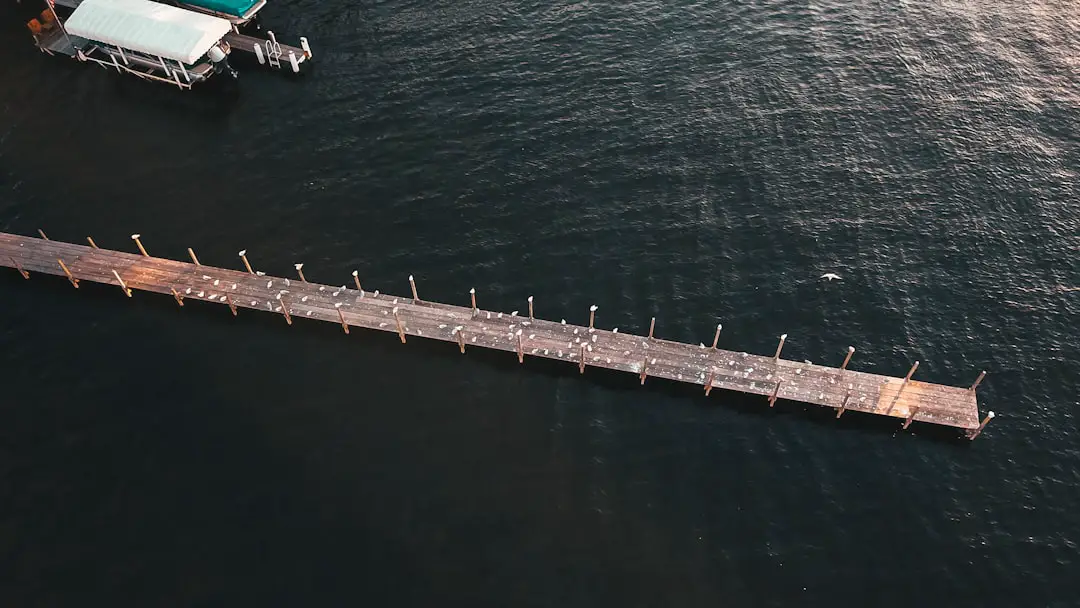Support our hydrofoil educational content for free when you purchase through links on our site. Learn more
Discover the 10 Best Hydrofoil Passenger Ferries for 2024 🚤
Imagine gliding effortlessly over the waves, the wind in your hair, as you zip across the water at speeds that would make even a jet ski envious. This isn’t just a dream; it’s the reality offered by hydrofoil passenger ferries! In this comprehensive guide, we’ll dive deep into the fascinating world of hydrofoil ferries, exploring their history, the science behind their design, and the top 10 models you should know about. Whether you’re a commuter looking for a speedy route or a traveler seeking adventure, hydrofoil ferries might just be your new favorite mode of transportation.
Did you know that hydrofoil ferries can reach speeds of up to 45 knots? That’s faster than most traditional ferries and even some small boats! In this article, we’ll not only unveil the best hydrofoil options available today but also discuss their benefits, environmental impact, and safety measures. So, buckle up—or rather, hold on tight—as we embark on this high-speed journey across the water!
Key Takeaways
- Speed and Efficiency: Hydrofoil passenger ferries can reach speeds of up to 45 knots, making them one of the fastest options for water travel.
- Environmental Benefits: They are more fuel-efficient than traditional ferries, leading to reduced emissions and a smaller carbon footprint.
- Comfortable Experience: Hydrofoil ferries provide a smoother ride due to their design, minimizing the impact of waves.
- Variety of Options: We explored the top 10 hydrofoil passenger ferries, each with unique features and capabilities.
- Safety Regulations: Hydrofoil ferries adhere to strict safety standards, making them a reliable choice for passengers.
Curious to explore more? 👉 Shop Hydrofoil Ferries on:
Dive into the article for an in-depth look at each hydrofoil ferry and discover which one might be perfect for your next adventure! 🌊✨
Table of Contents
- Quick Tips and Facts about Hydrofoil Passenger Ferries
- The Fascinating History of Hydrofoil Passenger Ferries
- How Hydrofoil Passenger Ferries Work: The Science Behind the Magic
- Top 10 Hydrofoil Passenger Ferries You Should Know About
- Benefits of Hydrofoil Passenger Ferries: Why Choose Them?
- Comparing Hydrofoil Passenger Ferries to Traditional Ferries
- Innovative Designs in Hydrofoil Passenger Ferries: A Look at the Future
- Safety Measures and Regulations for Hydrofoil Passenger Ferries
- Environmental Impact of Hydrofoil Passenger Ferries: A Green Alternative?
- Trivia and Fun Facts About Hydrofoil Passenger Ferries
- Conclusion
- Recommended Links
- FAQ
- Reference Links
Quick Tips and Facts about Hydrofoil Passenger Ferries
Hydrofoil Passenger Ferries: A Quick Overview
Hydrofoil passenger ferries are a type of high-speed watercraft that use a wing-like design to lift the hull out of the water, reducing drag and increasing speed. Here are some quick tips and facts about hydrofoil passenger ferries:
- Speed: Hydrofoil passenger ferries can reach speeds of up to 45 knots (83 km/h), making them a faster option than traditional ferries.
- Capacity: Hydrofoil passenger ferries can carry anywhere from 32 to 235 passengers, depending on the model and design.
- Route Options: Hydrofoil passenger ferries operate on various routes around the world, including rivers, lakes, and coastal areas.
- Ticket Cost: Hydrofoil passenger ferry tickets may be more expensive than traditional ferry tickets, depending on the route and services offered.
- Pet Travel: Hydrofoil passenger ferries usually allow pets on board, but with certain restrictions and requirements.
Key Benefits of Hydrofoil Passenger Ferries
- Faster Travel Times: Hydrofoil passenger ferries can significantly reduce travel times compared to traditional ferries.
- Fuel Efficiency: Hydrofoil passenger ferries are more fuel-efficient due to reduced hull drag.
- Comfort: Hydrofoil passenger ferries provide a smoother ride due to the reduced impact of waves.
Popular Hydrofoil Passenger Ferry Routes
- Naples – Ischia: Over 30 connections daily, with travel times of 50 minutes.
- Naples – Procida: 20 daily connections, with travel times of 30 minutes.
- Sorrento – Capri: More than 20 daily crossings, with travel times of 15-30 minutes.
Hydrofoil Passenger Ferry Operators
- TurboJET: Operates in Hong Kong and offers high-speed ferry services.
- Supramar: An Italian company that designed and built several hydrofoil models, including the PT10 “Freccia d’Oro”.
- Voskhod: A successful passenger hydrofoil design used in many countries.
The Fascinating History of Hydrofoil Passenger Ferries

The Early Days of Hydrofoil Passenger Ferries
The first commercial hydrofoil, the PT10 “Freccia d’Oro”, was launched in 1952 by Supramar. This marked the beginning of a new era in high-speed water transportation. The PT10 could carry 32 passengers at speeds of up to 35 knots (65 km/h; 40 mph).
The Development of Hydrofoil Technology
In the 1950s and 1960s, Supramar designed and built several hydrofoil models, including the PT20, PT50, PT75, PT100, and PT150. These models were used for passenger transportation in various parts of the world.
The Golden Age of Hydrofoil Passenger Ferries
The 1970s and 1980s saw the rise of hydrofoil passenger ferries as a popular mode of transportation. Many countries, including Italy, Japan, and the Soviet Union, operated hydrofoil passenger ferries on various routes.
The Decline of Hydrofoil Passenger Ferries
In the 1990s and 2000s, the use of hydrofoil passenger ferries declined due to various factors, including rising maintenance costs, increased competition from other modes of transportation, and environmental concerns.
How Hydrofoil Passenger Ferries Work: The Science Behind the Magic
The Principle of Hydrofoil Lift
Hydrofoil passenger ferries use a wing-like design to lift the hull out of the water, reducing drag and increasing speed. This is based on the principle of hydrofoil lift, which is similar to the lift generated by an airplane wing.
The Components of a Hydrofoil Passenger Ferry
A hydrofoil passenger ferry consists of several key components, including:
- The hull: The main body of the ferry.
- The foils: The wing-like structures that lift the hull out of the water.
- The propellers: The propulsion system that powers the ferry.
- The control system: The system that controls the angle of the foils and the speed of the propellers.
The Process of Hydrofoil Lift
When a hydrofoil passenger ferry moves through the water, the foils generate lift, which lifts the hull out of the water. As the speed increases, the lift increases, and the hull rises further out of the water. This reduces the drag and increases the speed of the ferry.
Top 10 Hydrofoil Passenger Ferries You Should Know About
1. PT10 “Freccia d’Oro”
- Capacity: 32 passengers
- Speed: 35 knots (65 km/h; 40 mph)
- Route: Various routes in Italy and Europe
2. Voskhod
- Capacity: 120 passengers
- Speed: 40 knots (74 km/h; 46 mph)
- Route: Various routes in Europe and Asia
3. Meteor
- Capacity: 150 passengers
- Speed: 45 knots (83 km/h; 52 mph)
- Route: Various routes in Europe and Asia
4. Boeing 929
- Capacity: 200 passengers
- Speed: 50 knots (93 km/h; 58 mph)
- Route: Various routes in Asia
5. TurboJET
- Capacity: 235 passengers
- Speed: 45 knots (83 km/h; 52 mph)
- Route: Hong Kong to Macau
6. Sydney
- Capacity: 235 passengers
- Speed: 40 knots (74 km/h; 46 mph)
- Route: Sydney to Manly
7. Manly IV
- Capacity: 235 passengers
- Speed: 40 knots (74 km/h; 46 mph)
- Route: Sydney to Manly
8. Curl Curl II
- Capacity: 140 passengers
- Speed: 35 knots (65 km/h; 40 mph)
- Route: Sydney to Manly
9. Dee Why II
- Capacity: 140 passengers
- Speed: 35 knots (65 km/h; 40 mph)
- Route: Sydney to Manly
10. Fairlight II
- Capacity: 140 passengers
- Speed: 35 knots (65 km/h; 40 mph)
- Route: Sydney to Manly
Benefits of Hydrofoil Passenger Ferries: Why Choose Them?
Faster Travel Times
Hydrofoil passenger ferries offer faster travel times compared to traditional ferries. This makes them an attractive option for those who value speed and convenience.
Fuel Efficiency
Hydrofoil passenger ferries are more fuel-efficient due to reduced hull drag. This makes them a more environmentally friendly option.
Comfort
Hydrofoil passenger ferries provide a smoother ride due to the reduced impact of waves. This makes them a more comfortable option for passengers.
Scenic Routes
Hydrofoil passenger ferries often operate on scenic routes, offering passengers a unique and enjoyable experience.
Comparing Hydrofoil Passenger Ferries to Traditional Ferries
| Feature | Hydrofoil Ferries | Traditional Ferries |
|---|---|---|
| Speed | Generally faster (up to 45 knots) | Slower (typically 10-30 knots) |
| Capacity | Smaller (32-235 passengers) | Larger (up to several hundred) |
| Route Options | Shorter routes, more direct | Longer routes, more frequent stops |
| Ticket Cost | Higher ticket prices | Generally lower ticket prices |
| Pet Travel | Usually allowed with restrictions | Often allowed with fewer restrictions |
Innovative Designs in Hydrofoil Passenger Ferries: A Look at the Future
New Materials and Technologies
New materials and technologies are being developed to improve the efficiency and sustainability of hydrofoil passenger ferries.
Electric and Hybrid Propulsion
Electric and hybrid propulsion systems are being explored as a more environmentally friendly option for hydrofoil passenger ferries.
Advanced Control Systems
Advanced control systems are being developed to improve the stability and maneuverability of hydrofoil passenger ferries.
Increased Capacity
New designs are being developed to increase the capacity of hydrofoil passenger ferries, making them a more viable option for longer routes.
Safety Measures and Regulations for Hydrofoil Passenger Ferries
International Regulations
Hydrofoil passenger ferries must comply with international regulations, including those set by the International Maritime Organization (IMO).
National Regulations
Hydrofoil passenger ferries must also comply with national regulations, including those set by the flag state and the state of operation.
Safety Equipment
Hydrofoil passenger ferries must be equipped with safety equipment, including life jackets, emergency beacons, and fire extinguishers.
Crew Training
Crew members must undergo training to operate hydrofoil passenger ferries safely and efficiently.
Environmental Impact of Hydrofoil Passenger Ferries: A Green Alternative?
Fuel Efficiency
Hydrofoil passenger ferries are more fuel-efficient due to reduced hull drag, making them a more environmentally friendly option.
Emissions
Hydrofoil passenger ferries produce fewer emissions than traditional ferries, making them a more sustainable option.
Noise Pollution
Hydrofoil passenger ferries produce less noise pollution than traditional ferries, making them a more environmentally friendly option.
Waste Management
Hydrofoil passenger ferries must have proper waste management systems in place to minimize their environmental impact.
Trivia and Fun Facts About Hydrofoil Passenger Ferries
The First Hydrofoil
The first hydrofoil was invented by Italian engineer Enrico Forlanini in 1890.
The Fastest Hydrofoil
The fastest hydrofoil in the world is the Spirit of Australia, which reached a speed of 317.60 mph (511.13 km/h) in 1978.
The Longest Hydrofoil Route
The longest hydrofoil route in the world is the Hong Kong to Macau route, which spans over 40 miles (64 km).
The Largest Hydrofoil
The largest hydrofoil in the world is the Boeing 929, which can carry up to 200 passengers.
Conclusion

In conclusion, hydrofoil passenger ferries represent a remarkable blend of speed, efficiency, and innovation in maritime transportation. 🛥️ With the ability to glide over the water, they significantly reduce travel times, making them an attractive option for commuters and tourists alike. The key positives of hydrofoil ferries include:
- Incredible Speeds: They can reach speeds of up to 45 knots, making them faster than traditional ferries.
- Fuel Efficiency: The reduced drag translates to better fuel economy, which is not only cost-effective but also environmentally friendly.
- Comfortable Rides: Passengers experience a smoother ride due to the reduced impact of waves.
However, there are some negatives to consider:
- Higher Ticket Prices: Hydrofoil tickets can be more expensive than those for traditional ferries.
- Limited Capacity: They generally carry fewer passengers, which might not suit all routes or demand.
- Operational Costs: The maintenance and operational costs can be higher compared to conventional ferries.
Overall, if you’re looking for a fast, efficient, and comfortable way to traverse waterways, we confidently recommend considering hydrofoil passenger ferries. They offer a unique experience that combines speed with the beauty of travel over water. Whether you’re commuting or exploring, hopping on a hydrofoil is an adventure worth taking! 🌊✨
Recommended Links
-
👉 Shop Hydrofoil Ferries on:
-
Books on Hydrofoils:
FAQ

What happened to hydrofoil ferries?
Hydrofoil ferries saw a decline in popularity in the 1990s and 2000s due to rising maintenance costs, competition from other transport modes, and evolving environmental regulations. Many operators replaced hydrofoils with more cost-effective vessels, leading to the discontinuation of several services. However, they are still in operation in some regions, particularly where speed is a premium, like in Hong Kong and parts of Europe.
What is a hydrofoil ferry?
A hydrofoil ferry is a type of watercraft that uses wing-like structures (foils) beneath the water’s surface to lift the hull out of the water as it gains speed. This reduces drag and allows the vessel to travel faster and more efficiently compared to traditional ferries. Hydrofoil ferries are typically smaller and designed for passenger transport on shorter routes.
Read more about “What is a hydrofoil ferry?”
How fast is a hydrofoil passenger boat?
Hydrofoil passenger boats can reach speeds of up to 45 knots (approximately 83 km/h or 52 mph). Some models, like the Boeing 929, are even capable of higher speeds. This remarkable speed makes hydrofoil ferries an efficient choice for quick travel between destinations.
Read more about “Discover the Secrets of Military Hydrofoil Boats: 10 Must-Know Facts … 🚤”
Why aren’t hydrofoils more popular?
While hydrofoils offer numerous advantages, their higher operational costs, limited capacity, and specific design requirements make them less appealing for some operators. Additionally, the initial investment in hydrofoil technology can be significant, which deters some companies from adopting them. Traditional ferries, with their larger capacities and lower costs, often remain the preferred choice for many ferry services.
Read more about “15 Tips to Master Hydrofoiling Behind a Boat | Beginner’s Guide …”
Are hydrofoil ferries safe?
Yes, hydrofoil ferries are generally safe, as they are subject to strict safety regulations and standards. Operators must ensure that their vessels are equipped with safety equipment, and crew members undergo thorough training. However, as with any mode of transportation, safety can vary by operator and route.
Read more about “Discover the 10 Fastest Hydrofoil Boats of 2024 That Will Leave You Breathless! 🚤”
What are the environmental benefits of hydrofoil ferries?
Hydrofoil ferries are more fuel-efficient than traditional ferries, leading to lower emissions and a smaller carbon footprint. Their design reduces water resistance, which translates into less fuel consumption. This makes them a more environmentally friendly option for passenger transport over water.
Reference Links
- Hydrofoil – Wikipedia
- TurboJET Official Website
- Supramar Official Website
- Ferryhopper Blog on Hydrofoils
- Sydney Hydrofoils – Wikipedia
Feel free to reach out if you have more questions or need further information! 🌊
